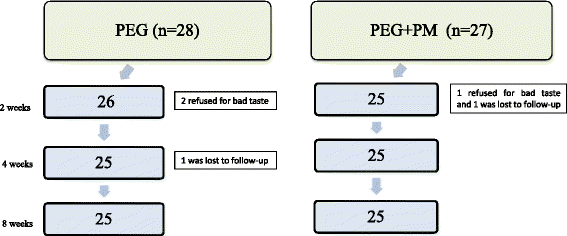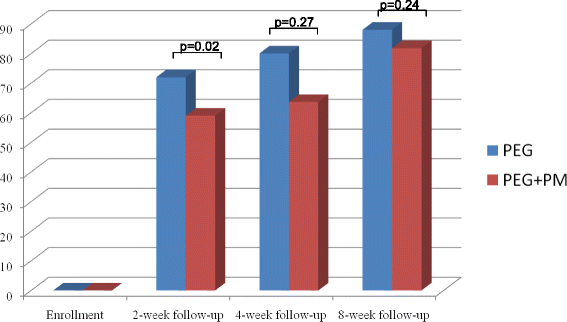Efficacy of a mixture of probiotic agents as complementary therapy for chronic functional constipation in childhood
- PMID: 28270173
- PMCID: PMC5341202
- DOI: 10.1186/s13052-017-0334-3
Efficacy of a mixture of probiotic agents as complementary therapy for chronic functional constipation in childhood
Abstract
Background: About 30% of constipated children continue to struggle with constipation beyond puberty. Growing interest has recently raised on the use of probiotics as complementary therapy for FC, in order to prevent the possible PEG-related intestinal dysbiosis. Our study aimed at evaluating the effect on childhood FC of a probiotic mixture (PM), including Bifidobacteria breve M-16 V®, infantis M-63®, and longum BB536®.
Methods: Fifty-five consecutive children suffering from FC were randomly assigned into two groups: group A received a daily oral combination of PEG plus PM and group B received oral PEG only. Physical and clinical data were collected from each patient at week-1, week-2, week-4, and week-8.
Results: After 1 month, children who experienced improvement in the PEG and in the PEG + PM group were 88 and 81.8%, respectively (p = 0.24). After 1 month from the end of the study treatment, a positive trend towards a higher rate of clinical remission was observed within children treated with PM compared to those who took only PEG (percentage of children off therapy: 64 vs 52, respectively; p = 0.28).
Conclusions: PEG and PEG + PM are equally effective and safe in the treatment of children with chronic constipation. Nevertheless, further studies are needed to show if adding Bifidobacteria strains to conventional therapy may lead to a better long-term outcome.
Keywords: Constipation; Polyethylene glycol; Probiotics.
Figures
References
-
- Baker S, Liptak G, Colletti R, Croffie J, Di Lorenzo C, Ector W, et al. Evaluation and treatment of constipation in children: summary of updated recommendations of the North American Society for Pediatric Gastroenterology, Hepatology and Nutrition. J Pediatr Gastroenterol Nutr. 2000;30(1):109. doi: 10.1097/00005176-200001000-00033. - DOI
-
- Staiano A. Use of polyethylene glycol solution in functional and organic constipation in children. Ital J Gastroenterol Hepatol. 1999;31(Suppl 3):S260–3. - PubMed
Publication types
MeSH terms
Substances
LinkOut - more resources
Full Text Sources
Other Literature Sources
Medical



